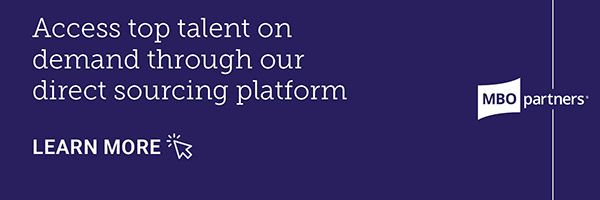How to Win the Great Realization: Adding Contingent Workers to Your Workforce Strategy

Key Points
Using third-party staffing or consulting firms to find talent can be risky as these companies don’t always specialize in finding contingent workers.
Direct sourcing is a workforce strategy where hiring managers find contingent workers internally.
If you classify a worker as an independent contractor when that person should actually be classified as an employee, your company may be audited or sued.
There has never been a better—or easier—time to engage contingent workers. More than 64.4 million Americans are now working as independents. That number is up 69% from 2020, and it makes sense. People who work independently report being happier, healthier, and wealthier than their traditionally-employed counterparts. What’s more, some 68% say they’re more financially secure than they would be working a full-time, permanent job.
So, what does this mean for you? It means the opportunity to hire highly-talented people has never been greater. And then, your projects will have the right talent with the right skill sets to innovate and build towards your goals. It means it’s time to make contingent workers part of your workforce strategy.
How do I find the right contingent workers?
If you’re new to it, freelancers can be harder to find than traditional employees. Using third-party staffing or consulting firms can be risky. These companies don’t always specialize in finding contingent workers. But, relying on your company’s HR department can lead to compliance issues. They might be unfamiliar with the legal ins-and-outs of independent contractor classification. Here are some alternative strategies to consider:
1. Implement a direct sourcing strategy
Direct sourcing is a workforce strategy where hiring managers find contingent workers internally. Methods will vary depending on the size of your company, budget, and freelancer needs.
For instance, you might use your own network to find talent or direct sourcing technology. MBO’s marketplace, for example, uses a matching algorithm to pair qualified talent with opportunities at your company.
Check out the MBO Partners Marketplace
2. Attract the right talent
Finding the right contingent worker starts with writing an accurate, detailed description of what you are looking for. This will help you draw in the best possible matches.
In your job description, outline goals for the project. And then, describe any special skills you’re looking for. Include as many details as you can. Think about things like: the number of hours you expect this person to work and a date and pay range. Consider whether there are travel requirements, or if you have any desired licenses or certifications.
3. Plan for the future
As you meet with freelancers, think about your future needs. Maybe someone has a great background and experience but isn’t a perfect match for an existing project. Can you use their services in the future?
A virtual talent bench is a group of contingent workers who have already performed all onboarding steps. They’ve already had background checks and validated work arrangements and the like. A virtual bench lets you quickly deploy freelancers when a specific project need or role arises.
Read Next: How to Access, Engage, and Manage Your Independent Workforce
3 Tips to Compliantly Engage Your Contingent Worker
When engaging contingent workers of any kind—freelancers, consultants, self-employed professionals, side-giggers, etc.—it is important to know that they are not your typical W-2 employees. “Independent contractor” is a legal term for workers who are not considered full-time employees.
If you classify a worker as an independent contractor when that person should actually be classified as an employee, your company may be audited or sued. Here are three steps to keep your company compliant.
1. Define employment status for all of your workers
Defining employment status is an important compliance step. Ask for proof of self-employment. This can include: a business or professional license, proof of insurance, or business cards. Keep these records on file to help support independent contractor status.
A signed contract is another opportunity to define status. Include a statement that says your company and the freelancer agree to an independent contractor relationship. The freelance worker should note they’re not entitled to any employee benefits and they’re responsible for paying their own taxes. These practices help to confirm a business-to-business relationship. Remember, contingent workers are free to determine how, when, and where they work, among other factors.
2. Understand classification laws
Worker classification is complicated. Federal agencies, like the Department of Labor (DOL) and Internal Revenue Service (IRS), have guidance documents for businesses. And, keep in mind, different states have different laws.
These laws and guidance documents can contradict one another. They are constantly evolving, and they are open to interpretation. A worker can be seen as a freelancer from one perspective and an employee from another. This creates confusion for workers and businesses. As you start to engage contingent workers, become familiar with these agencies and your state laws. If you’re unsure how to navigate these legal nuances, work with a firm like MBO that can provide enterprise risk mitigation.
3. Keep your records up-to-date for every single independent worker on your team
Updating records is an essential workforce strategy when working with freelancers. Perform a yearly check to make sure business licenses and insurance requirements have not expired. Check in with your virtual bench. Are your freelancers still performing contracting services? Do their businesses still meet your requirements as a client?
Ask for proof of paid Self-Employment tax, for a recent Statement of Work, their latest resume, and marketing materials such as a professional website or business cards. Ask for confirmation that they have control over how and when they do their work. Keeping these records on file and up-to-date is a good best practice to support classification status and ensure your company is operating compliantly.
Want more tips? Check out our guide on the Best Practices for Independent Contractor Engagement!
The information provided in the MBO Blog does not constitute legal, tax or financial advice. It does not take into account your particular circumstances, objectives, legal and financial situation or needs. Before acting on any information in the MBO Blog you should consider the appropriateness of the information for your situation in consultation with a professional advisor of your choosing.
Related Posts
Trending
Subscribe to our
blog
Get a weekly email of our latest posts sent straight to your inbox
Learn more about the MBO Platform
FOR INDEPENDENT
PROFESSIONALS
Start, run, and grow
your independent business with MBO
FOR
ENTERPRISES
Engage, scale, and optimize
your independent workforce



